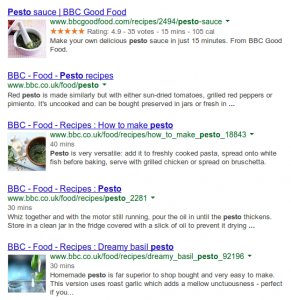What makes a good website in 2014? Here are the top 8 most important priorities a business website must have to be successful and competitive today.
1. Responsive design

Responsive design: example seravo.fi
The share of mobile devices is growing all the time so websites are required to work on devices of all sizes. Responsive design means that the layout of a website automatically adapts to the screen dimensions. The same site works across all devices automatically and no platform specific versions needs to be developed.
In general the website must work on a broad spectrum of devices and browsers. HTML5 is the best technology (not Flash) as HTML5 is universally supported. All that is needed is a web browser, and all smart devices from phones to TVs have one.
While at it, update the design to look stunning. People have grown accustomed to ever more good looking and easy to use websites and apps.
2. Search engine optimization

Micro formats example on query ‘pesto’.
The majority of visitors to a website come via search engines (mostly Google). With search engine optimization you get free search engine visibility and perhaps don’t need to buy ads. The headings and texts should describe the company using the most common terms, so that when somebody enters these terms in a search engine, the website has a chance of being in the results.
In addition to relevant content, the technical presentation must also be correct. Semantic contents mean that the human readable contents is embedded in machine readable metadata that search engines and other machines can process. For example navigation and content should be semantically separated. Images should be described in meta attributes. Prices, opening hours, addresses etc. should marked using micro formats.
3. Fast loading
The amount of mobile users (who in general have slow connections) has increased, and the speed of wired connections hasn’t significantly increased either. Having a website that loads fast is still very relevant. This is particularly demanding as websites should be ever more impressive, but the file size of big images should not grow.
Even small differences matter if there are lots of users: Amazon reports that their sales grew 1 % for each 100 milliseconds their site was optimized to load faster.
Fast pages get better higher search engine rankings. Do you want more users, who stay at your site for longer and are more return more often? Invest in speed.
4. Good web addresses
Shorter equals better: Easier to remember, easier to type on a touch screen, easier to fit in the 140 characters of a tweet…
Using the www in domains is useless. Simply example.com is enough.
Carefully choose domain names with your most important keyword embedded, as it has a big impact on search engine results.
For example for the seach ”auto” the first results are: autotrader.co.uk, autoexpress.co.uk, auto-europe.co.uk, auto-italia.co.uk, autocar.co.uk
5. Social media integration
A website needs to share content where people already are, so that the content gets visibility. Push out your contents to Facebook, Twitter, Google+ and other similar services. Visibility sparks interest to visit the website. While users visit your website, promote sharing to social networks. Two-way integration leads to a positive loop!
Social media integration example: share buttons on a website
Also remember map services and directory services. Traditional channels still have their users: provide a RSS feed and an e-mail subscription option.
6. Visitor analytics
For most businesses the point of a website is to increase visibility among potential customers. Well, how many potential customers has there been then? Do you have statistics and analytics?
All investments into a website should be guided by the expected results (ROI). Results should be evaluated from visitor statistics. A weekly PDF report is easy to automate!
7. Easy to update
Stylishness is an important part of the visitor impression, but content in most important. At minimum the content should be correct and current. Wrong information (e.g. price, address, opening hours) on a website will make people angry and spur mistrust.
Management must always remember the website and value it as the most important communication channel.
Updating the contents should be so easy that even the CEO can do it alone, without delay or costs.
The more contents, the bigger the likelihood to be seen on somebody’s search engine results page. In social media, only new content has potential to spread, not old. Does this sound familiar: ”Sure, I’ll update as soon as I have time and can properly concentrate on it…”
There must be a dead easy tool for content management!
8. Affordable to improve

WordPress is the worlds most popular content management software.
There is always something to improve. But there’s not always lots of resources? Development must be affordable, otherwise it will be infeasible to update the website to the standards of 2014. And 2015, and 2016…
The most costly things that can happen in relation to software is related to vendor lock-in. Make sure you legally actually own your contents. Remember to save documents in an open standards format and not in proprietary formats that are not future-proof. Prefer systems that are open source and avoid being a hostage of closed source software.
Break the vendor lock! Even an initially good solution will by time become just a vendor lock = monopoly = expensive. Open source software is the cure to single vendor lock-in.
See graphics in our presentations
This article is based on the presentation held in the Seravo salad lunch in January 2014. Below are the presentation slides in English and Finnish. If you live or work near Tampere, check out the schedule of our next Seravo salads!



Thanks for the article it was well written and helpful in my research.